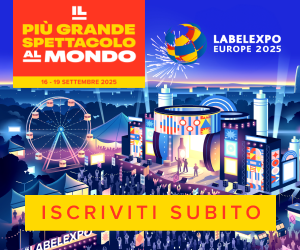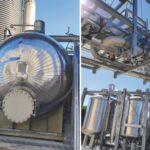Rotogravure printing and lamination were on center-stage at the open house organized by Bobst Italia in May. But the Group is also growing in other converting segments and, with the acquisition of Nuova Gidue, consolidates its position in narrow web.
Once again this year, Bobst Italia invited more than 60 converters from around the world, hosting them at the concern’s Competence Center in San Giorgio Monferrato to see demos of the new machines’ performance and speed. The two machines shown are among the most successful Bobst solutions in their target sectors: the Rotomec 4003MP counts more than 200 installations worldwide, while the CL 850 laminators, automated and high tech, predominate the two important markets of Italy and Germany.

Lamination on the Bobst CL 850D at the Competence Center di Bobst Italia.
More and more flexible rotogravure. The rotary Rotomec 4003MP shown in May was configured for shaftless gravure cylinders and equipped with an integrated washing system and Twin Trolley.
First the press was set in register using the TAPS system, through a sequence that was completed automatically in less than five minutes. Then the machine accelerated to a production speed of 450m/min before performing an automatic splice on the rewinder at the same speed. The demo continued with a color change from a light to a dark color, before resuming printing at full speed for a few minutes. The operator then brought the press to a halt and carried out the washing sequence, followed by a change of color from dark back to light again. After another run of printing and another automatic splice, the machine was stopped. These operations were designed to show the efficiency of the Rotomec 4003MP in terms of performance of its register control and its rapidity of print unit set up and job changeover, but also the quality of its washing system. To this end, before and after each color change, samples were taken in order to conduct testing with the spectrophotometer: the very low Delta E values in the two samples proved the effectiveness of the Bobst integrated washing system in preventing cross-color contamination.
For its part, the Twin Trolley showed the system’s flexibility in quick job setup and ink logistics, with significant saving due to reduced waste of ink and solvent.
Lamination and coating: an exercise in precision
After seeing the rotogravure printing demo, visitors witnessed the functioning of the CL 850 D duplex lamination system, equipped with a flexo trolley. In fact, the Bobst flexo trolley was appreciated especially in processes involving direct coating of solvent-based adhesives onto thin aluminium. After the demo, visitors could see for themselves the product’s perfection: a composite 2-layer material, made up of a 7 micron aluminium foil and a 12 micro PET film.

L’unità di stampa Rotomec 4003MP allo stand del gruppoBobst a Converflex 2015.
Growing in labels and short runs
Last May, with an acquisition that made waves, Bobst Group acquired ownership of 65% of shares (and the option of buying the remainder) in Nuova Gidue. The small but dynamic manufacturers of narrow and medium web printing for labels and flexible packaging thus consolidates the presence of the Swiss giant in flexo and offset printing.
Erik Bothorel, head of the Bobst Web-fed Business Unit and a member of the group’s board of directors, remarked: «We want to grow in the segment of labels and establish ourselves as a leader in short runs for flexible packaging. The Nuova Gidue technologies integrate our offer and contribute significantly to our innovation and performance».
With a 2014 turnover of 31 million euro and 60 employees, Nuova Gidue was the recipient of the Global Label Award 2014, and in May 2015, obtained the first prize of the FTA (Flexographic Technical Association). In the spotlight, in particular, are its Digitali Flexo™ technologies and its standardization work in this field as the head of the REVO Team.
A digital machine for corrugated board. Bobst puts the onus on digital and presents a sheetfed machine for 4 color printing on a wide range of coated or uncoated corrugate substrates.
Undergoing the beta test phase at the Swiss concern Model AG, it enables the high speed, high quality printing of variable data at a max speed of 200 m/min, with formats up to 1.3 x 2.1 m. The machines use the Kodak imaging Stream Inkjet technology, synonymous with bright colors and high print resolution, that enables the use of food compatible inks.













